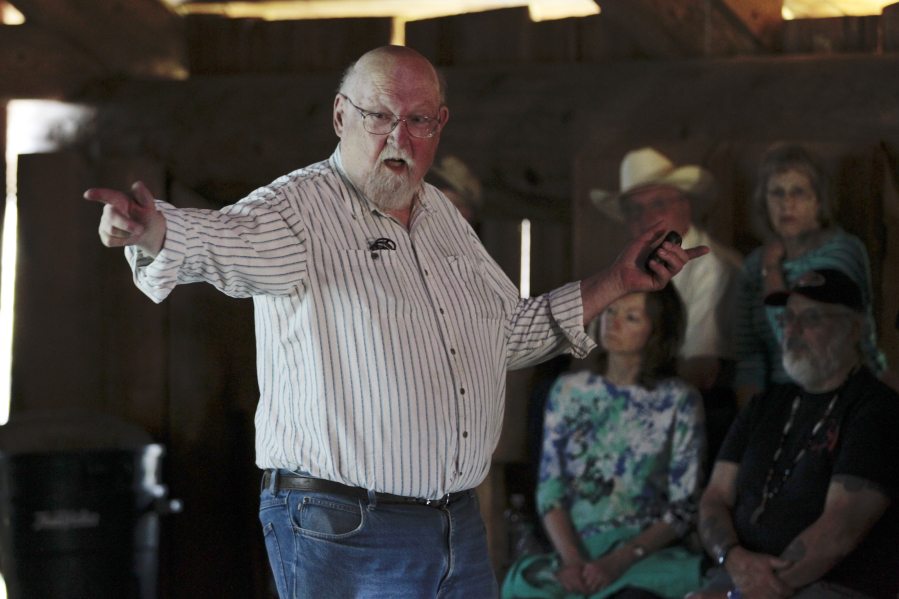RIDGEFIELD — When archeologist Ken Ames set out to research the American Indians who once lived along the Columbia River near present-day Ridgefield, he had some assumptions about what he would learn.
Some of those assumptions turned out to be dead wrong, he told a history-hungry crowd Sunday inside a replica Chinookan plankhouse.
Initially, Ames said, he figured that the hundreds of Chinookan people living at the Cathlapotle site first became aware of Europeans in 1792, when an expedition led by English Captain George Vancouver stopped on the Columbia’s shores.
But as Ames and a team of Portland State University researchers began digging where the village once stood, they found copper and iron pieces, and a chunk of Chinese porcelain — all of which were at the village about a century before Vancouver arrived. Ames now believes that those items came from European ships that crashed along the Pacific Coast. The porcelain might be from the so-called Beeswax Shipwreck, in which a Spanish ship capsized along the Oregon Coast in the late 1600s, he said.
The Cathlapotle villagers “knew something was out there,” Ames said, “and they had known about it for a long time.”
Another unexpected discovery was that many Chinookan houses had large, underground cellars, a building feature not found at other American-Indian excavations sites, Ames said. Inside the cellars, archeologists found broken tools, seeds, smelt bones, elk parts — “all kinds of stuff,” Ames said.
The Cathlapotle dig began in the 1990s and included the former site of six Chinookan houses. The most-populated home housed about 215 people while the most sparsely populated building housed nearly 40, researchers learned. The biggest house took about 100 trees and 2,000 person-hours to build, and many more trees were required over the years for its upkeep.
“These houses took a fair amount of work” and used a roughly 6,000-year-old building technique, Ames said.
Ames said researchers began to unravel a longer and more complicated history of the village than initially thought. The six houses weren’t constructed all at once; the first three at the Cathlapotle site were built in the mid-1300s, while the remaining houses were built about 150 years later. The village’s population already had begun to decline by the time Meriwether Lewis and William Clark came across it in 1805. By the 1840s, the village was abandoned.
Unanswered questions
Despite the surprises archeologists uncovered, mysteries remain, Ames said. Perhaps the biggest head-scratcher concerns all of the different types of “projectile points” — items such as arrowheads or spear tips — found at the Cathlapotle site, even within the same house. That kind of variety didn’t exist at another Chinookan village just 8 miles away, where the people there mostly used just one method for making their projectile points.
Researchers wondered if the difference exists because perhaps the people at Cathlapotle hunted animals that the people in the other village did not. Researchers crunched the numbers as many ways as they could, trying to find a connection.
“No,” Ames said. “It’s not related to animals at all.”
The finding might suggest a culture at Cathlapotle that was less rigid when it comes to tradition than other Chinookan villages in the region, Ames said. Perhaps in the other villages, children were brought up to make their projectile points all one way, but things were more relaxed at Cathlapotle, Ames mused.
His presentation, which drew about 70 people, was part of an event Sunday marking the season opening of the Cathlapotle Plankhouse replica at the Ridgefield National Wildlife Refuge. After Ames spoke, some visitors took a guided hike through part of the refuge.
Vancouver residents Alys and Beth Webber said they attended the talk because they have an interest in American Indian history. Alys Webber studied the subject at Washington State University, and Beth Webber has visited other American Indian sites as far east as North Dakota.
“It was really interesting,” Beth Webber said. “I like to come to this kind of thing and find out what was, and what is, and people’s interpretation of it.”




